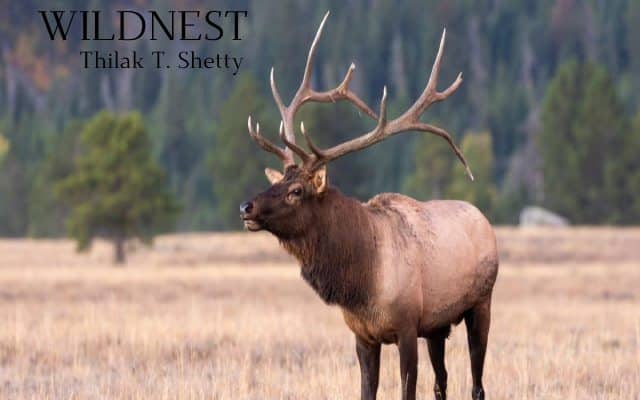The elk, or wapiti, is one of the largest species within the deer family, Cervidae, and one of the largest terrestrial mammals in its native range of North America and Central and East Asia. The word elk is derived from the ancient Germanic root word meaning “stag” or “hart.” In Europe, elk is the common name for moose. The elk is the second largest extant species of deer, after the moose. The International Union for Conservation of Nature and Natural Resources (IUCN) list the species as the least-concern species.
Elks have thick bodies with slender legs and short tails. They have a shoulder height of 0.75–1.5 m with a nose-to-tail length of 1.6–2.7 m. Males are larger and weigh 178–497 kg while females weigh 171–292 kg. Body mass varies considerably within and between populations and increases from south to north. Compared with other red deer, female elk are more similar to bulls in external appearance and body mass. During winter all elk have well-developed, dark-neck manes that contrast sharply with their tan or light brown body colour. Antlers are made of bone, which can grow at a rate of 2.5 centimetres (0.98 in) per day. While actively growing, a soft layer of highly vascularized skin known as velvet covers and protects them. This is shed in the summer when the antlers have fully developed. Bull elk typically have around six lines on each antler.
During the fall, elk grow a thicker coat of hair, which helps to insulate them during the winter. Both male and female North American elk grow thin neck manes; females of other subspecies may not. By early summer, the heavy winter coat has been shed. Elk are known to rub against trees and other objects to help remove hair from their bodies. All elk have small and clearly defined rump patches with short tails. They have different colourations based on the seasons and types of habitats, with grey or lighter colouration prevalent in the winter and a reddish, darker coat in the summer.
Elk are classic red deer in their biology. However, they are more highly adapted to life in open plains, to grazing, and too cold, long winters. They evolved as fast endurance runners that are very difficult to catch even with the best of horses, particularly in broken terrain. Nevertheless, they get their chief protection from predators by forming large groups. The elk ranges from central Asia through to Siberia east Asia and North America. They can be found in open deciduous woodlands, boreal forests, upland moors, mountainous areas and grasslands.
Elk is among the most gregarious deer species. During the summer group size can reach 400 individuals. For most of the year, adult males and females are segregated into different herds. Female herds are larger while bulls form small groups and may even travel alone. Young bulls may associate with older bulls or female groups. Male and female herds come together during the mating season, which may begin in late August. Males try to intimidate rivals by vocalizing and displaying with their antlers. If neither bull backs down, they engage in antler wrestling, sometimes sustaining serious injuries. Bulls have a loud, high-pitched, whistle-like vocalization known as bugling, which advertises the male’s fitness over great distances.
Female elk have a short estrus cycle of only a day or two, and matings usually involve a dozen or more attempts. By the autumn of their second year, females can produce one and, very rarely, two offspring. Reproduction is most common when cows weigh at least 200 kilograms. Dominant bulls follow groups of cows during the rut from August into early winter. A bull will defend his harem of 20 cows or more from competing bulls and predators. Bulls also dig holes in the ground called wallows, in which they urinate and roll their bodies. A male elk’s urethra points upward so that urine is sprayed almost at a right angle to the punished urine soaks into their hair and gives them a distinct smell which attracts cows.
A bull interacts with cows in his harem in two ways: herding and courtship. When a female wanders too far away from the harem’s range, the male will rush ahead of her, blocking her path and aggressively rushing her back to the harem. Herding behaviour is accompanied by a stretched-out and lowered neck and the antlers laid back. A bull may get violent and hit the cow with his antlers. During courtship, the bull is more peaceful and approaches her with his head and antlers raised. The male signals his intention to test the female for sexual receptivity by flicking his tongue. If not ready, a cow will lower her head and weave from side to side while opening and closing her mouth. The bull will stop in response in order not to scare her. Otherwise, the bull will copiously lick the female and then mount her.
Younger, less dominant bulls, known as “spike bulls” because their antlers have not yet forked, will harass unguarded cows. These bulls are impatient and will not perform any courtship rituals and will continue to pursue a female even when she signals them to stop. As such, they are less reproductively successful, and a cow may stay close to the big bull to avoid harassment. Dominant bulls are intolerant of spike bulls and will chase them away from their harems.
Elk have played an important role in the cultural history of a number of people.
Neolithic petroglyphs from Asia depict antler-less female elk, which have been interpreted as symbolizing life and sustenance.
They were also frequently overlaid with boats and associated with rivers, suggesting they also represented paths to the underworld.
The elk was of particular importance to the Lakota and played a spiritual role in their society. The male elk was admired for its ability to attract mates, and Lakota men will play a courting flute imitating a bugling elk to attract women. Men used elks’ antlers as love charms and wore clothes decorated with elk images.

















